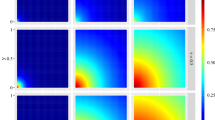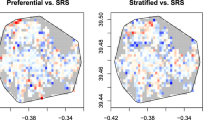Abstract
Customary and routine practice of geostatistical modeling assumes that inter-point distances are a Euclidean metric (i.e., as the crow flies) when characterizing spatial variation. There are many real-world settings, however, in which the use of a non-Euclidean distance is more appropriate, for example, in complex bodies of water. However, if such a distance is used with current semivariogram functions, the resulting spatial covariance matrices are no longer guaranteed to be positive-definite. Previous attempts to address this issue for geostatistical prediction (i.e., kriging) models transform the non-Euclidean space into a Euclidean metric, such as through multi-dimensional scaling (MDS). However, these attempts estimate spatial covariances only after distances are scaled. An alternative method is proposed to re-estimate a spatial covariance structure originally based on a non-Euclidean distance metric to ensure validity. This method is compared to the standard use of Euclidean distance, as well as a previously utilized MDS method. All methods are evaluated using cross-validation assessments on both simulated and real-world experiments. Results show a high level of bias in prediction variance for the previously developed MDS method that has not been highlighted previously. Conversely, the proposed method offers a preferred tradeoff between prediction accuracy and prediction variance and at times outperforms the existing methods for both sets of metrics. Overall results indicate that this proposed method can provide improved geostatistical predictions while ensuring valid results when the use of non-Euclidean distances is warranted.










Similar content being viewed by others
Change history
08 May 2019
The original version of this article unfortunately contained a mistake in equation 9.
References
Berman JD, Breysse PN, White RH, Waugh DW, Curriero FC (2015) Evaluating methods for spatial mapping: applications for estimating ozone concentrations across the contiguous United States. Environ Technol Innov 3:1–10
Bivand R, Keitt T, Rowlingson B (2016) rgdal: bindings for the geospatial data abstraction library, R package version 1.1-10 edn.
Boisvert JB (2010) Geostatistics with locally varying anisotropy. University of Alberta, Edmonton
Boisvert JB, Deutsch CV (2011) Programs for kriging and sequential Gaussian simulation with locally varying anisotropy using non-Euclidean distances. Comput Geosci 37:495–510
Cheng SH, Higham NJ (1998) A modified Cholesky algorithm based on a symmetric indefinite factorization. SIAM J Matrix Anal Appl 19:1097–1110
Chesapeake Bay Program (2017) Data hub: CBP GIS datasets. Chesapeake Bay Program. https://www.chesapeakebay.net/what/data. Accessed 17 Sept 2015
Congdon CD, Martin JD (2007) On using standard residuals as a metric of kriging model quality. In: Proceedings of the 48th AIAA/ASME/ASCE/AHS/ASC structures, structural dynamics, and materials conference, Honolulu HI
Core Team R (2016) R: a language and environment for statistical computing. R Foundation for Statistical Computing, Vienna
Cressie NAC (1993) Statistics for spatial data, Revised edn. Wiley, London
Curriero FC (2006) On the use of non-euclidean distance measures in geostatistics. Math Geol 38:907–926
Datta A, Banerjee S, Finley AO, Gelfand AE (2016) On nearest-neighbor Gaussian process models for massive spatial data. Wiley Interdiscip Rev Comput Stat 8:162–171
Davis BJ, Jacobs JM, Davis MF, Schwab KJ, DePaola A, Curriero FC (2017) Environmental determinants of Vibrio parahaemolyticus in the Chesapeake Bay. Appl Environ Microbiol 83:e01117–e01147
Del Castillo E, Colosimo BM, Tajbakhsh SD (2015) Geodesic gaussian processes for the parametric reconstruction of a free-form surface. Technometrics 57:87–99. https://doi.org/10.1080/00401706.2013.879075
Diggle PJ, Ribeiro PJ (2007) Model-based geostatistics. Springer series in statistics. Springer, New York
ESRI (2011) ArcGIS desktop: release 10.3. Environmental Systems Research Institute, Redlands
ESRI (2016) Cross Validation. esri. http://desktop.arcgis.com/en/arcmap/10.3/tools/geostatistical-analyst-toolbox/cross-validation.htm. Accessed 27 June 2016
Etten JV (2015) gdistance: distances and routes on geographical grids, R package version 1.1-9 edn.
Gardner B, Sullivan PJ, Lembo AJ Jr (2003) Predicting stream temperatures: Geostatistical model comparison using alternative distance metrics. Can J Fish Aquat Sci 60:344–351
Hengl T, Heuvelink GB, Stein A (2004) A generic framework for spatial prediction of soil variables based on regression-kriging. Geoderma 120:75–93
Henshaw SL, Curriero FC, Shields TM, Glass GE, Strickland PT, Breysse PN (2004) Geostatistics and GIS: tools for characterizing environmental contamination. J Med Syst 28:335–348
Higham NJ (2002) Computing the nearest correlation matrix: a problem from finance. IMA J Numer Anal 22:329–343
Jeffrey SJ, Carter JO, Moodie KB, Beswick AR (2001) Using spatial interpolation to construct a comprehensive archive of Australian climate data. Environ Model Softw 16:309–330
Jensen OP, Christman MC, Miller TJ (2006) Landscape-based geostatistics: a case study of the distribution of blue crab in Chesapeake Bay. Environmetrics 17:605–621
Kane MJ, Emerson J, Weston S (2013) Scalable strategies for computing with massive data. J Stat Softw 55:1–19
Laaha G, Skøien J, Blöschl G (2014) Spatial prediction on river networks: comparison of top-kriging with regional regression. Hydrol Process 28:315–324
Little LS, Edwards D, Porter DE (1997) Kriging in estuaries: as the crow flies, or as the fish swims? J Exp Mar Biol Ecol 213:1–11
Liu R, Young MT, Chen J-C, Kaufman JD, Chen H (2016) Ambient air pollution exposures and risk of Parkinson disease. Environ Health Perspect 124:1759
Løland A, Host G (2003) Spatial covariance modelling in a complex coastal domain by multidimensional scaling. Environmetrics 14:307–321. https://doi.org/10.1002/env.588
Lu B, Charlton M, Fotheringham AS (2011) Geographically Weighted Regression using a non-Euclidean distance metric with a study on London house price data. In: Procedia environmental sciences, pp 92-97. https://doi.org/10.1016/j.proenv.2011.07.017
Lu B, Charlton M, Harris P, Fotheringham AS (2014) Geographically weighted regression with a non-Euclidean distance metric: a case study using hedonic house price data. Int J Geogr Inf Sci 28:660–681. https://doi.org/10.1080/13658816.2013.865739
Lucas C (2001) Computing nearest covariance and correlation matrices. M.S, Thesis, University of Manchester
Maechler M (2016) sfsmisc: utilities from “Seminar fuer Statistik” ETH Zurich, R package version 1.1-0 edn.
Mardia KV, Kent JT, Bibby JM (1979) Multivariate analysis. Academic Press, London
Matheron G (1971) The theory of regionalized variables and its applications. Les Cah Morphol Math 5:218
Meyer D, Dimitriadou E, Hornik K, Weingessel A, Leisch F (2015) e1071: Misc Functions of the Department of Statistics, Probability Theory Group (Formerly: E1071), TU Wien, R package version 1.6-7. edn.
Murphy R, Perlman E, Ball WP, Curriero FC (2015) Water-distance-based Kriging in Chesapeake Bay. J Hydrol Eng 20:0501403
Novomestky F (2012) matrixcalc: collection of functions for matrix calculations, R package version 1.0-3 edn.
Rathbun SL (1998) Spatial modelling in irregularly shaped regions: Kriging estuaries. Environmetrics 9:109–129
Ribeiro PJ, Diggle PJ (2016) geoR: analysis of geostatistical data, R package version 1.7-5.2 edn.
Roweis ST, Saul LK (2000) Nonlinear dimensionality reduction by locally linear embedding. Science 290:2323–2326. https://doi.org/10.1126/science.290.5500.2323
Rowlingson B, Diggle P (2015) splancs: spatial and space-time point pattern analysis, R package version 2.01-38 edn.
Sampson PD, Guttorp P (1992) Nonparametric estimation of nonstationary spatial covariance structure. J Am Stat Assoc 87:108–119
Schlather M, Malinowski A, Menck PJ, Oesting M, Strokorb K (2015) Analysis, simulation and prediction of multivariate random fields with package RandomFields. J Stat Softw 63:1–25
USGS (2016) The national hydrography dataset. https://nhd.usgs.gov/index.html. Accessed 3 Dec 2016
Ver Hoef JM (2018) Kriging models for linear networks and non-Euclidean distances: cautions and solutions. Methods Ecol Evol. https://doi.org/10.1111/2041-210x.12979
Wickham H (2009) ggplot2: elegant graphics for data analysis. Springer, New York
Yu H, Wang X, Qing J, Nie H (2015) ArcMap raster edit suite (ARES), 0.2.1 edn. https://github.com/haoliangyu/ares
Acknowledgements
This work was supported by the National Institutes of Allergy and Infectious Diseases [Grant No. 1R01AI123931-01A1 to F.C.C. (principal investigator)]. Additional support for B.J.K.D. was provided in part by the Johns Hopkins’ Environment, Energy, Sustainability & Health Institute Fellowship and the Center for a Livable Future-Lerner Fellowship, as well as The National Science Foundation’s Water, Climate, and Health Integrative Education and Research traineeship (Grant No. 1069213). The authors would like to thank Tim Shields for helping to develop the schematic maps displayed in this paper.
Author information
Authors and Affiliations
Corresponding author
Appendix A: List of Equations for Cross-Validation Metrics
Appendix A: List of Equations for Cross-Validation Metrics
Equations for the cross-validation metrics are provided below
where \( y_{i} \) is an observed outcome for location i, \( \widehat{y}_{i} \) is the predicted (i.e., kriged) value, and \( \widehat{\sigma }_{i} \) is the kriging standard error.
Rights and permissions
About this article
Cite this article
Davis, B.J.K., Curriero, F.C. Development and Evaluation of Geostatistical Methods for Non-Euclidean-Based Spatial Covariance Matrices. Math Geosci 51, 767–791 (2019). https://doi.org/10.1007/s11004-019-09791-y
Received:
Accepted:
Published:
Issue Date:
DOI: https://doi.org/10.1007/s11004-019-09791-y




